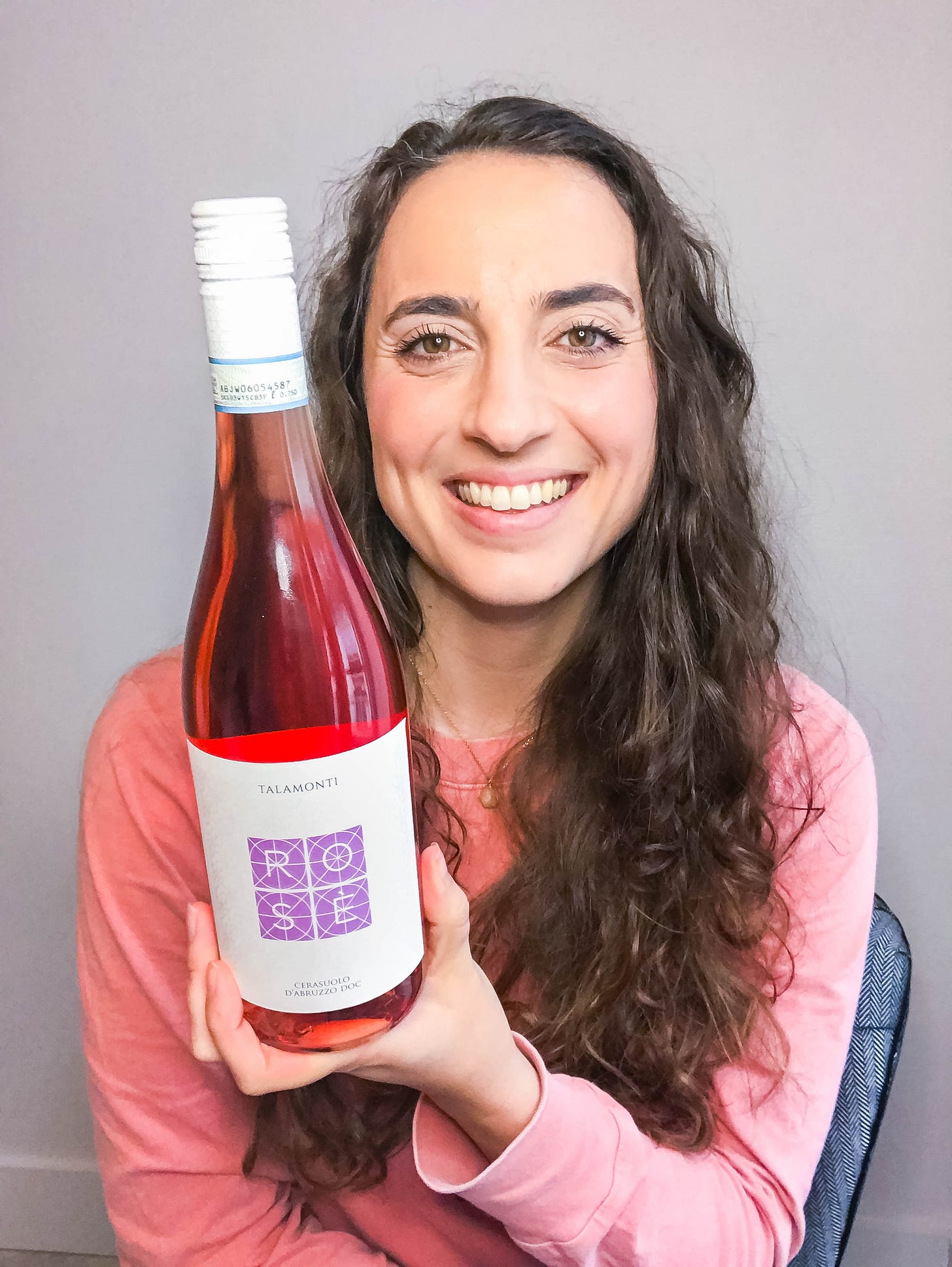The Rosé Edit: Regions, Styles & Bottles Worth Sipping
Rosé season is here! Join me in celebrating accordingly.
Rosé Revolution: A Quick Guide to the Best Regions & My Favorite Bottles
Are you a rosé lover, hater or somewhere in between?
Personally, I am a huge fan of rosé. My winemaker husband on the other hand basically despises the stuff. Maybe “despises” is too strong of a word, but it’s definitely never his first choice. Consequently, I’ve made it my personal mission to convert him to a rosé lover. Admittedly still with little success.
But I shall not be deterred!
Anyways, whether Marco wants to share a bottle with me or not, I’m still a massive fan and will continue to consume accordingly. Since we’re well into rosé season, I thought it’d be fun to put together a quick guide to some of my favorite rosé regions and styles, as well as give you a few recommended bottles. So, here we go…
How Rosé Is Made
To more effectively determine what styles of rosé you prefer, you should first understand the different production techniques used to make these wines.
Maceration
One of the most common methods used for making rosé is maceration. Similar to the red winemaking process, grapes are crushed and the juice sits with the skins while extracting color, flavor compounds, etc. A lighter rosé will macerate for a shorter amount of time. Whereas a darker rosé spends more time in contact with the skins. Depending on the winemaker’s goals for the wine, the maceration time can be as short as a few hours up to multiple days.
Direct Press
For fans of super delicately colored rosé wines, know that this style is often made using the direct press method. This method involves crushing and immediately pressing the red grapes, similar to the process of making white wine. The juice doesn’t spend time hanging out with the skins. Minimal color is extracted through the pressing process, which results in a lightly colored rosé.
Saignée
The saignée method (pronounced sahn-yay) is reliant on red wine production. Mid-maceration during red winemaking, a portion of the juice is bled off, or drained out of the tank, so that the remaining liquid in the tank becomes a more intensely concentrated red wine. The separated juice that’s been bled off gets fermented in a similar method to a white wine and becomes rosé.
Blending
Blending is the final method of rosé wine production. As you might imagine, it involves blending white wine with a touch of red to make a pink wine. Usually, it’s about 5-10% red wine, but that can vary. Several Old World regions actually do not permit this rosé production method. Though Champagne is the exception and blending is frequently the preferred method used in this legendary region.
My Favorite Rosé Regional Styles
There are tons of rosé wines out there, but the following are my personal favorites.
Tavel
Considered by wine professionals and gastronomes to be the best rosé in the world (yours truly included), Tavel is a French appellation worth exploring. The region is located in the Southern Rhône Valley on the right bank of the Rhône, between the pont d’Avignon and the pont du Gard. There are nine different varieties permitted in the wines of Tavel, including Syrah, Mourvèdre, Cinsault, Clairette, Grenache, Bourboulenc, Carignan, Picpoul, and Calitor.
Typically, Tavel undergoes a cold maceration for 12-24 hours resulting in a bolder style of rosé with deeper extraction, more intense color, bigger body, and concentrated flavors. The cool thing about Tavel rosé is that it’s fresh enough to drink in warmer months, yet bold and complex enough to drink in fall or winter, too. Plus, it’s famously food-friendly with its character-driven style.
A recent stand out for me: 2021 Château de Trinquevedel Tavel Rosé.
Beautiful deep copper color in the glass, quite intense color for a rosé, but that’s what I love about Tavel.
The nose is super savory with that trademark garrigue aroma typical of the Southern Rhône.
Notes of Tomato leaf. Earthiness. Dried rose petals. Not a lot of fruit coming through. Chewy acidity. Medium body. A bit tannic. Savory palate.
Really lovely rosé, would be great with food, especially something like a cheeseburger or a fried chicken sandwich.
I purchased this wine online at Flatiron SF, but they only have a small 375ml bottle. It looks like wine.com has the more recent 2023 vintage available here in a regular 750ml bottle. I will definitely be stocking up because this wine blew my mind in the best way. It’s imported by Kermit Lynch.
Learn more about the Tavel appellation here.
Provençal
There is no talking about rosé without talking about Provence. Known for setting the global standard for pale pink, refreshing rosé, this French region delivers wines that are light in color but far from boring. Located in the sun-drenched southeast of France, Provence has a Mediterranean climate and cooling coastal breezes that help grapes retain freshness and acidity. The wines are typically blends featuring Grenache, Cinsault, Mourvèdre, Syrah, Carignan, and Tibouren. Each contributes to the wine’s pale hue, fresh flavor profile, delicate red fruit, and signature herbal lift.
What I love about Provençal rosé is how crisp, mineral-driven, and thirst-quenching it is. It’s the kind of wine that tastes like summer, think strawberries, watermelon rind, sea spray, and fresh herbs like thyme or lavender. These wines are typically made with minimal skin contact (sometimes just a few hours), yielding their iconic blush pink color and lean, refreshing profile.
There are SO MANY rosés to choose from in Provence. Some are pretty mass-produced, but even those can be quite good. Here are few of my favorites:
Explore more of the terroir and wines from Provence here.
Cerasuolo d’Abruzzo
If you love rosé with bold fruit and serious depth, look no further than Cerasuolo d’Abruzzo. This Italian rosato is made from Montepulciano. Yes, the same grape responsible for rich red wines from the region. Montepulciano gives rosé wines a deeper cherry-red hue and an unmistakable intensity. “Cerasuolo” literally means “cherry-colored,” and that’s exactly what you get in the glass.
Despite its darker color, Cerasuolo d'Abruzzo is not heavy. It has vibrant acidity and an almost savory bite with notes of sour cherry, blood orange, wild herbs, and a touch of spice. It’s the kind of rosé you can chill in the summer or serve slightly warmer with hearty dishes in the fall. There’s real versatility here.
It’s been a minute since I’ve savored Cerasuolo d’Abruzzo, but one of my favorites is from Tenuta Talamonti.
If you’re curious to explore this style, Decanter has an enticing round up outlined here.
Etna Rosato
Sicily’s Mount Etna is one of the most exciting and dynamic wine regions in the world, and the rosato wines from here are unlike anything else. Made primarily from the native Nerello Mascalese grape, Etna Rosato combines the freshness of a cool-climate rosé with the volcanic energy of this dramatic landscape.
The wines tend to be pale copper to light ruby in color, with delicate aromas of citrus zest, alpine strawberries, wild herbs, and smoky minerality reflective of the volcanic soil. They’re elegant and structured, often with a subtle saltiness and a tension that makes each sip exciting.
I feel like you basically can’t go wrong with whatever Etna Rosato you choose, but some of my go-to’s are Cantina Calcagno, Pietradolce, and Barone di Villagrande.
My Favorite Varietal Styles
The options are endless when it comes to rosé. After all, you can technically make it from any red grape variety. Style, flavor, and structure will vary wildly depending on the grape itself and the region or terroir where it’s grown. That’s part of the fun. Here are a few of my personal favorite varietal-driven rosé styles.
Grenache
One of the most widely used grapes in rosé production, Grenache yields wines that are juicy, generous, and incredibly approachable. Expect bright flavors of ripe strawberry, watermelon, citrus zest, and sometimes a hint of white pepper or herbs. These rosés are typically fruit-forward and refreshing with just enough texture to keep things interesting. Whether from Provence, California, Sardinia, or Spain, Grenache-based rosés tend to be crowd-pleasers.
Carignan
Carignan rosé is the underdog I keep coming back to. It brings a savory edge and earthy depth that makes the wine feel grounded and serious, yet still fun. Flavors often lean into red plum, raspberry, dried herbs, and a subtle spice note, especially when grown in old vines or rugged, arid soils. There's usually a bit more structure and a wild streak that makes Carignan rosé ideal for pairing with richer fare or smoky grilled dishes. My father-in-law made a rosato from Carignano one year and I loved it so much he always saved bottles just for me. Sadly, we’ve drunk through that whole vintage and have no more Carignano rosato!
Cabernet Sauvignon
Cabernet Sauvignon might not be the first grape that comes to mind for rosé, but when done right, it can produce deeply flavorful, structured wines with serious presence. These rosés tend to have a darker hue and more tannin than lighter styles with flavors of black cherry, red currant, pink peppercorn, and sometimes even green bell pepper or graphite depending on ripeness and winemaking choices. They’re typically more savory, making them perfect for people who usually drink reds.
Now I want to hear from you!
Drop some of your favorite rosé wines in the comments below so we can stock up on the good stuff for rosé season.






